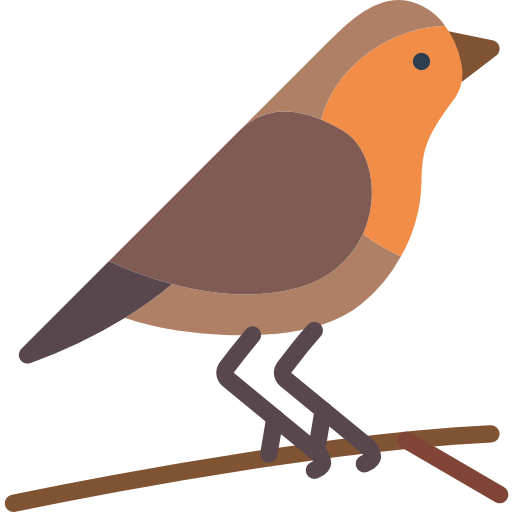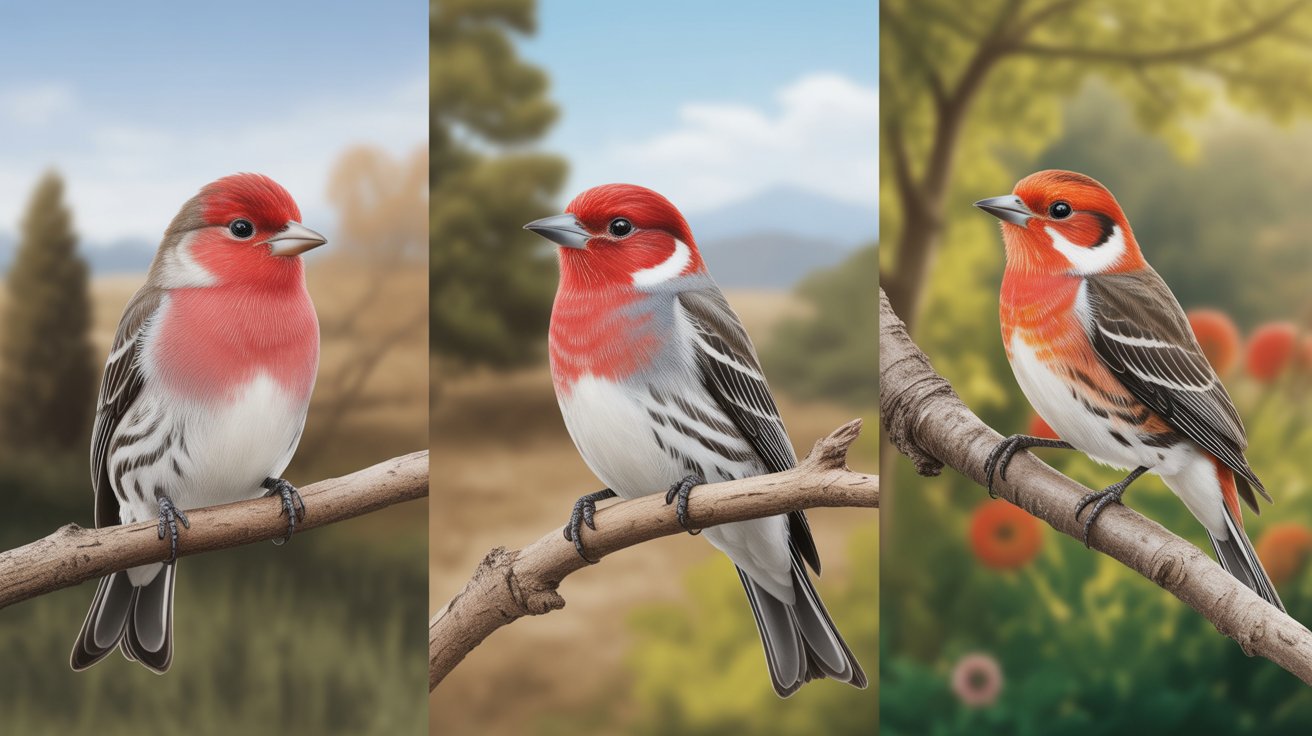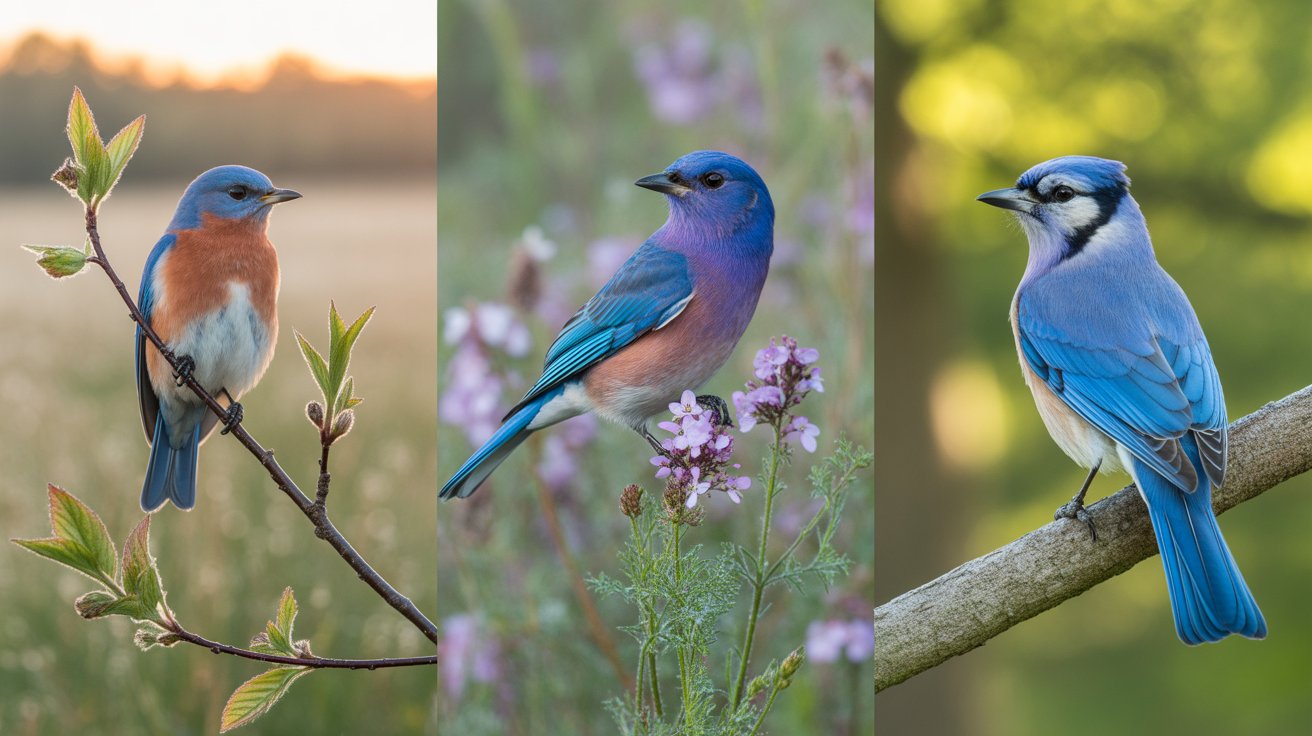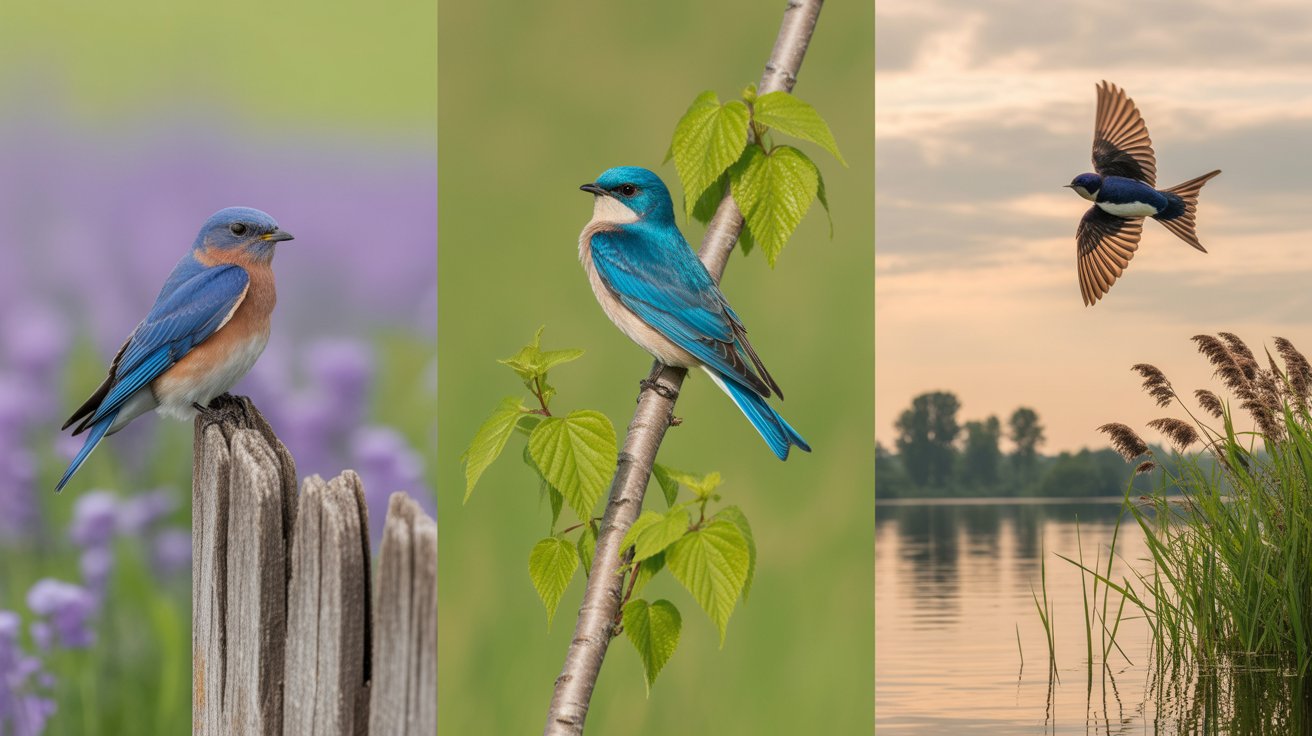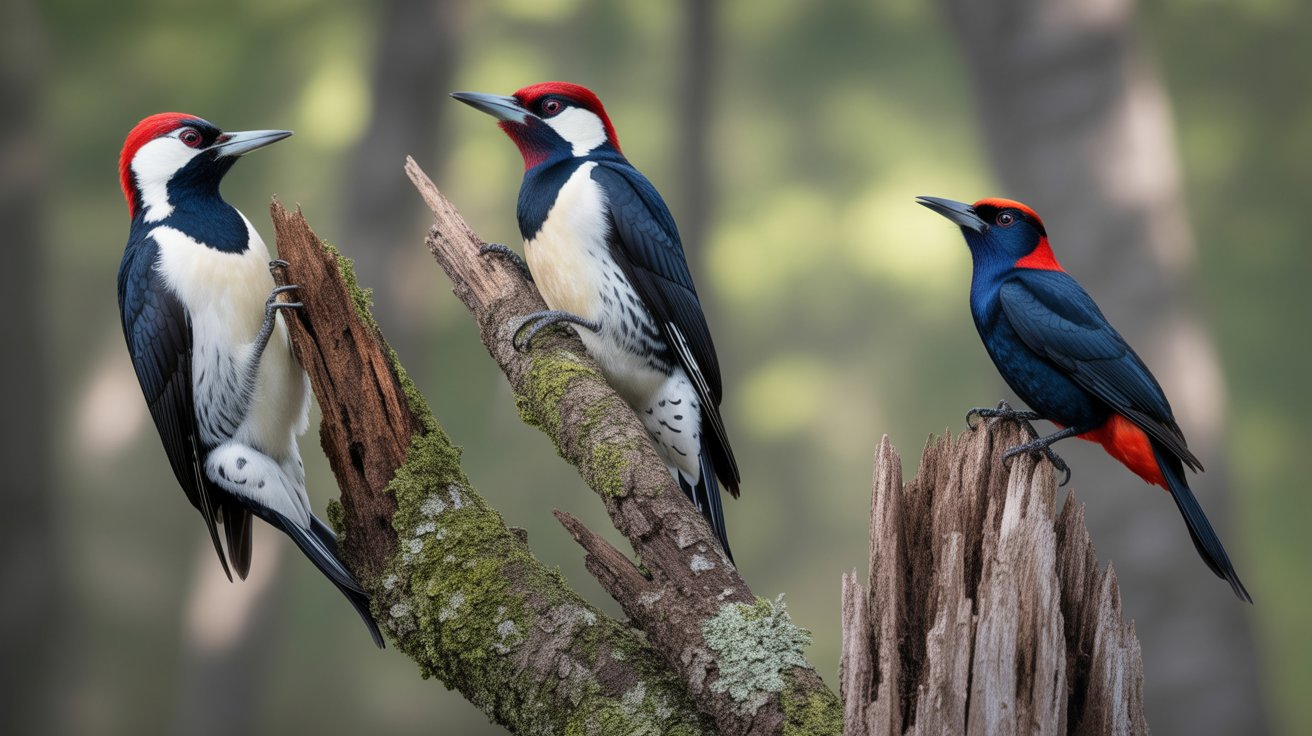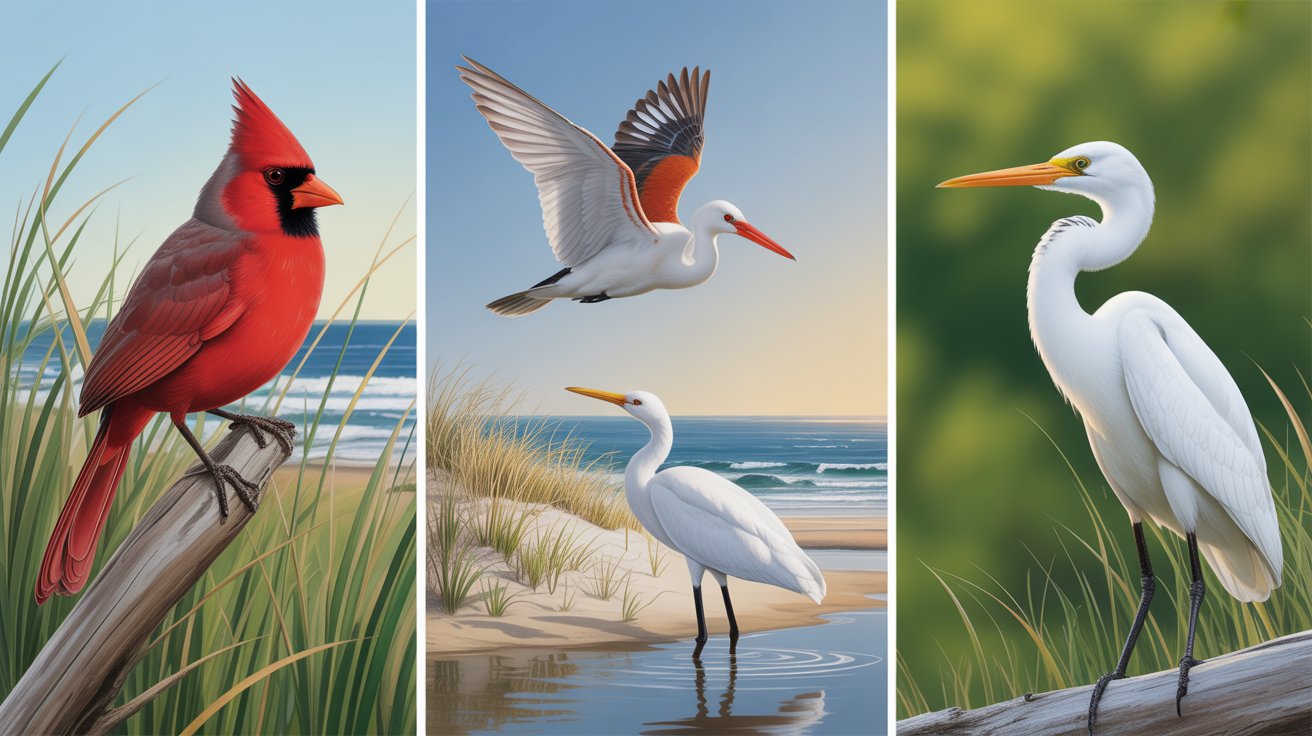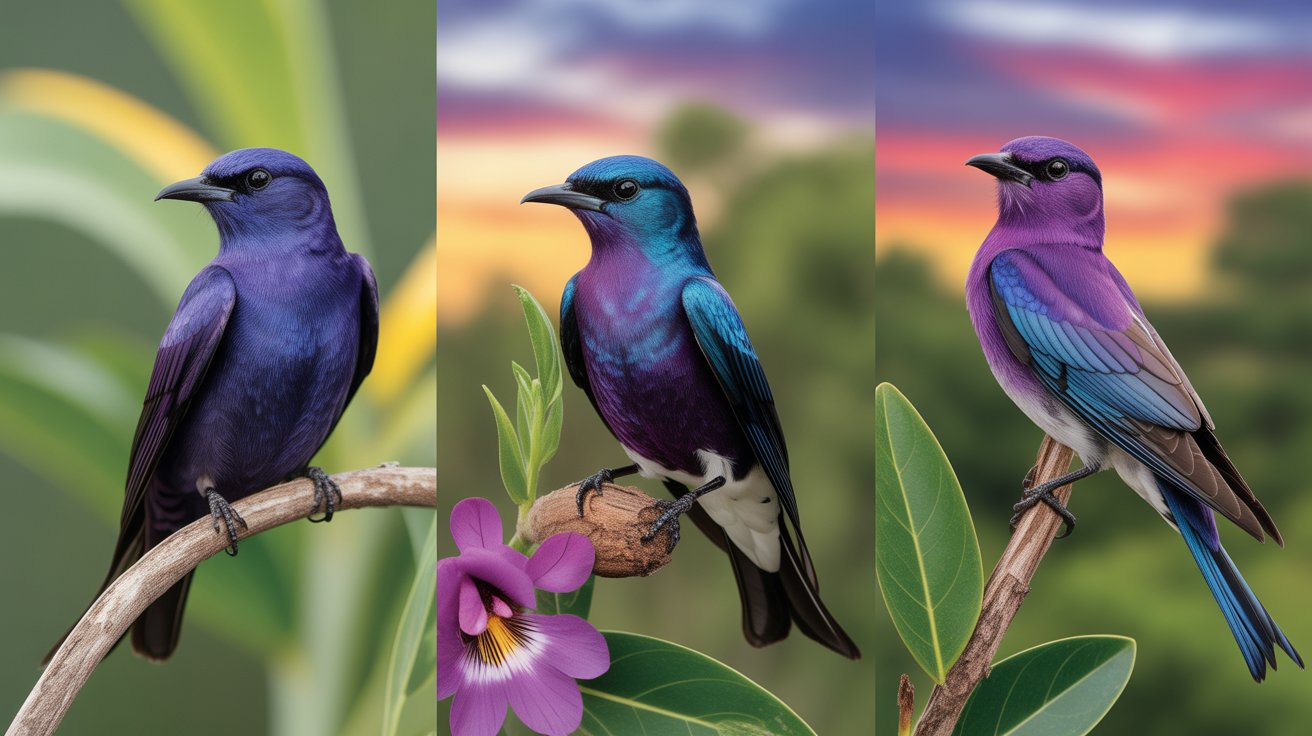Have you ever found yourself fascinated by the beauty and diversity of birds? Whether you’re an avid birdwatcher, a backyard nature lover, or simply someone who loves to learn interesting facts about the natural world, discovering new species can be endlessly rewarding. One fun way to expand your bird knowledge is by exploring birds alphabetically — and today, you’re about to meet 25 incredible birds whose names all start with the letter B.
You might be surprised at how varied these birds are. From tiny, colorful beauties to powerful predators, “B” birds can be found all over the world — in forests, wetlands, mountains, and even your own neighborhood. This list is designed to help you not only identify these amazing creatures but also understand what makes each one special.
Each section includes vivid descriptions, key facts, and helpful details like their scientific names, wingspans, lengths, and more. So grab your notebook, get comfortable, and let’s take a journey into the world of birds that begin with B. By the end of this guide, you’ll have a fresh list of feathered friends to watch for the next time you step outside or plan your next birding adventure.
Ready? Let’s dive in!
Contents
- 1. Bald Eagle
- 2. Barn Owl
- 3. Blue Jay
- 4. Black-capped Chickadee
- 5. Blackbird
- 6. Buzzard
- 7. Belted Kingfisher
- 8. Bowerbird
- 9. Black Swan
- 10. Brambling
- 11. Bluebird
- 12. Black Kite
- 13. Barn Swallow
- 14. Bearded Vulture
- 15. Boat-tailed Grackle
- 16. Buff-breasted Sandpiper
- 17. Black Skimmer
- 18. Brown Thrasher
- 19. Bohemian Waxwing
- 20. Bluethroat
- 21. Black Grouse
- 22. Black Tern
- 23. Bufflehead
- 24. Bullfinch
- 25. Buttonquail
- FAQs
- Conclusion
1. Bald Eagle
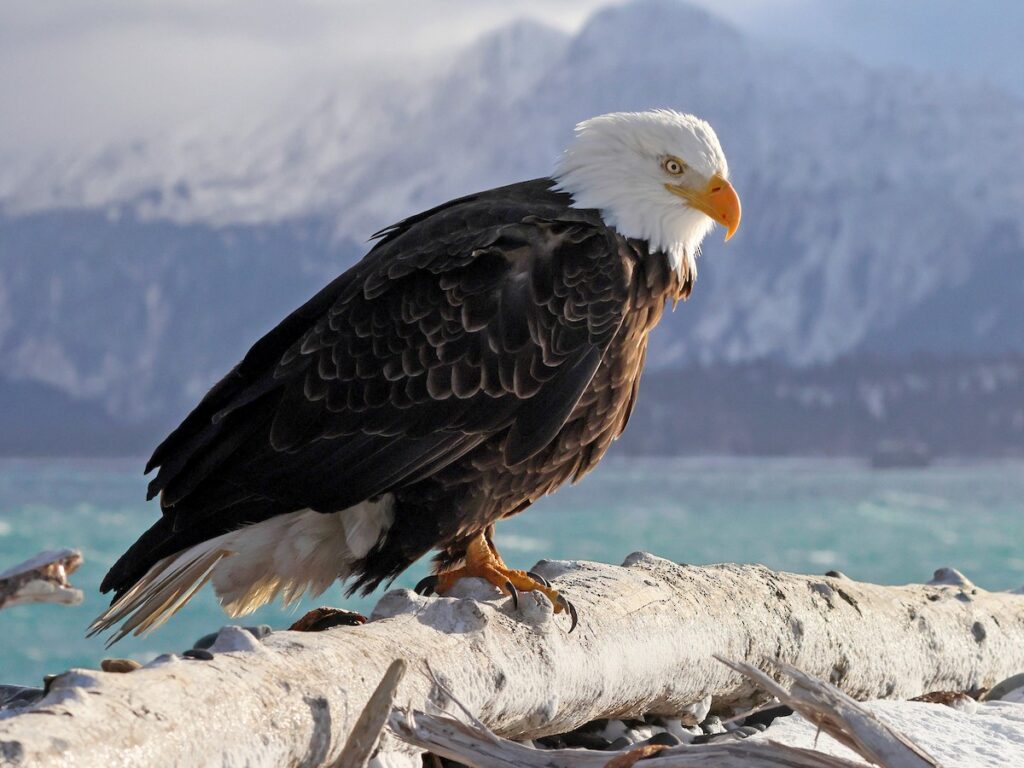
The Bald Eagle is one of the most iconic birds in North America and instantly recognizable with its striking white head and tail contrasting against a dark brown body. When you spot one soaring high in the sky, you can’t help but feel a sense of awe. These powerful raptors are not just symbols of freedom — they’re also fascinating creatures to observe in the wild.
Native to North America, Bald Eagles are usually found near large bodies of open water, such as lakes, rivers, and coastal regions where fish are abundant. They’re skilled hunters but also known for scavenging. Their nests, called eyries, are massive and can be reused for years, often growing larger each season.
Key Details:
- Scientific Name: Haliaeetus leucocephalus
- Wingspan: 6 to 7.5 feet (1.8 to 2.3 meters)
- Length: 28 to 40 inches (71 to 102 cm)
- Weight: 6.6 to 14 pounds (3 to 6.3 kg)
Watching a Bald Eagle swoop down and snatch a fish from the water is truly a sight to behold. If you’re lucky enough to live near a nesting area, take some binoculars and observe these majestic birds in their natural habitat — just remember to keep a respectful distance.
2. Barn Owl
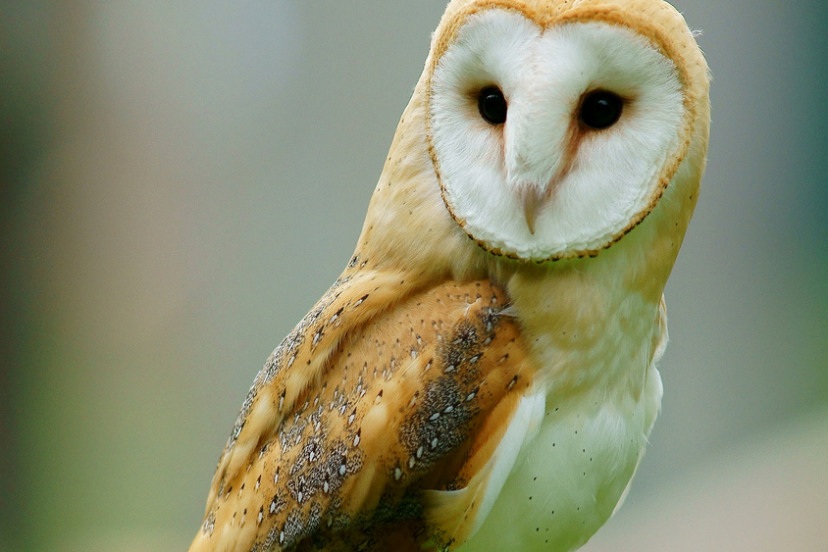
Barn Owls are easily one of the most hauntingly beautiful nocturnal birds you can encounter. With their heart-shaped faces, pale plumage, and ghostly silent flight, they’ve inspired myths and stories for centuries. If you live in rural areas, you might have heard their eerie screeching calls during the night.
These owls are master hunters of rodents and other small mammals, making them invaluable to farmers. They prefer open habitats like farmlands, grasslands, and marshes, often roosting in old barns — which is how they got their name.
Key Details:
- Scientific Name: Tyto alba
- Wingspan: 31 to 37 inches (80 to 95 cm)
- Length: 12 to 15 inches (30 to 38 cm)
- Weight: 0.9 to 1.4 pounds (400 to 630 grams)
Barn Owls have exceptional hearing and can locate prey in complete darkness. If you want to spot one, keep an eye out around dusk near old buildings or nest boxes put up by conservationists. Their ghostly shape floating over a field is something you’ll never forget.
3. Blue Jay
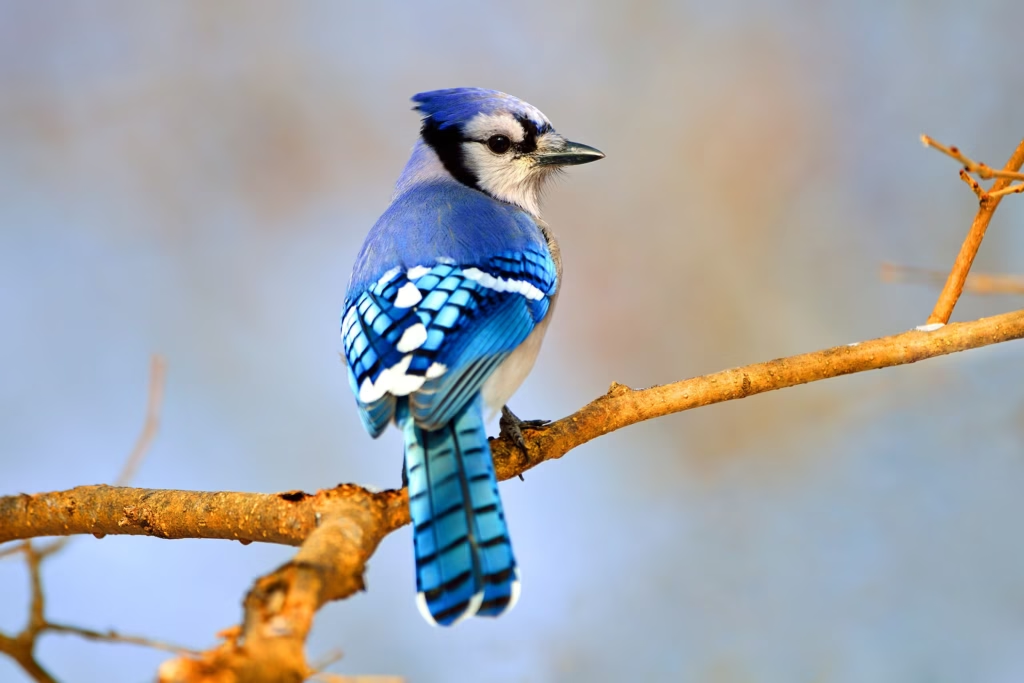
Vibrant, noisy, and full of personality — the Blue Jay is one of the most recognized backyard birds in North America. You’ll often hear their loud calls before you see their brilliant blue feathers. They’re known for their intelligence and curiosity, often mimicking other birds or even human sounds.
Blue Jays are quite social and can be seen visiting feeders, especially if you offer peanuts or sunflower seeds. They also play an important ecological role by spreading oak trees’ acorns.
Key Details:
- Scientific Name: Cyanocitta cristata
- Wingspan: 13 to 17 inches (34 to 43 cm)
- Length: 9 to 12 inches (23 to 30 cm)
- Weight: 2.5 to 3.5 ounces (70 to 100 grams)
If you’d like to attract Blue Jays to your yard, set up a feeder with nuts and provide fresh water. You’ll enjoy hours of entertainment watching these bold birds squabble and chatter in the trees.
4. Black-capped Chickadee
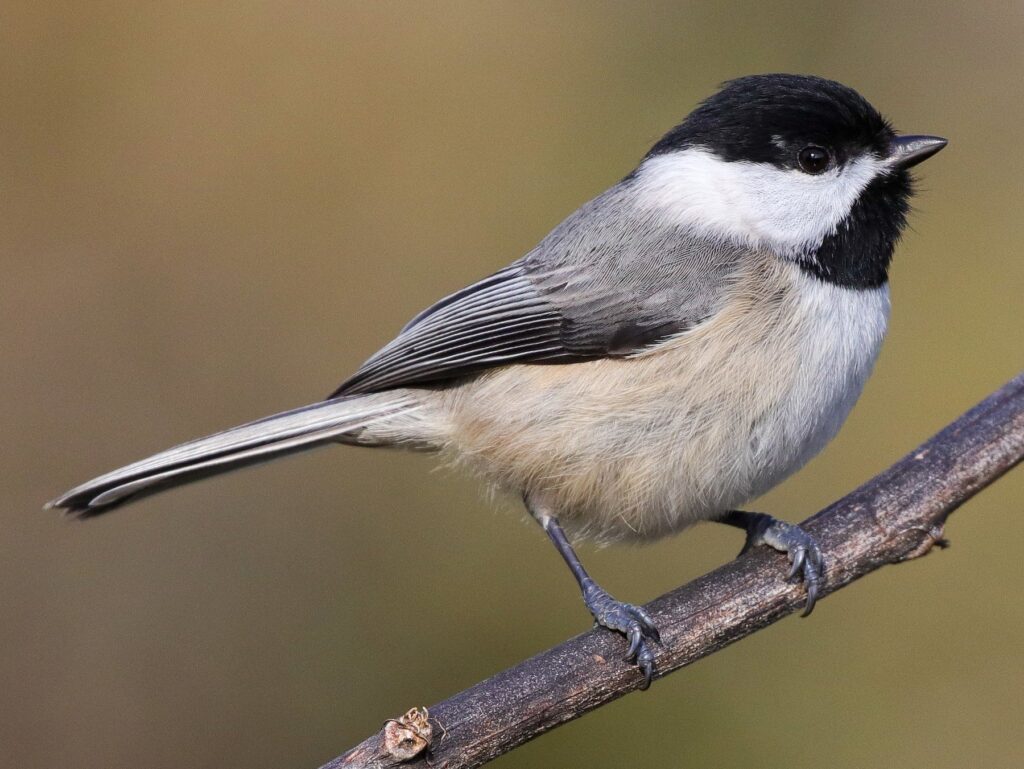
Tiny but endlessly charming, the Black-capped Chickadee is a delight for anyone who loves backyard birding. These small, round birds are easily recognized by their black caps and bibs, white cheeks, and cheerful “chick-a-dee-dee-dee” call — which is how they got their name.
Chickadees are remarkably friendly and can even be coaxed to eat from your hand with patience. They’re found in forests, parks, and gardens across North America and are hardy enough to stick around all winter.
Key Details:
- Scientific Name: Poecile atricapillus
- Wingspan: 6 to 8 inches (15 to 20 cm)
- Length: 4.7 to 5.9 inches (12 to 15 cm)
- Weight: 0.3 to 0.5 ounces (9 to 14 grams)
To attract them, hang feeders with sunflower seeds or suet. You’ll be rewarded with their playful antics and bold personalities year-round.
5. Blackbird
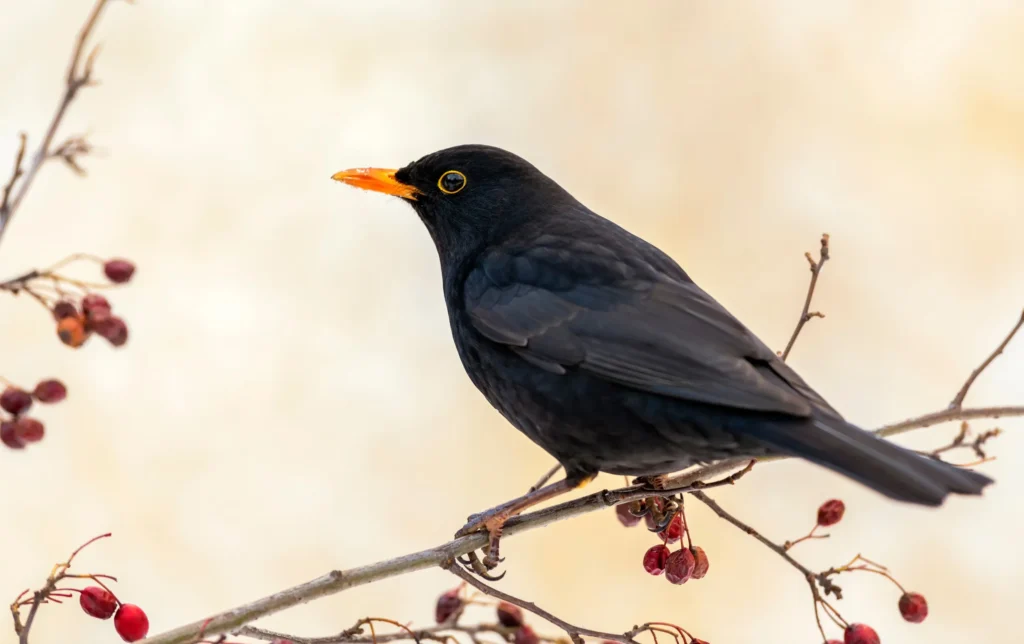
Blackbirds are widespread and easily spotted across Europe, Asia, and parts of North America. Known for their glossy black plumage and melodic songs, they bring a touch of music to gardens and woodlands alike.
Males are all black with bright yellow eye-rings and beaks, while females are usually brownish with speckled breasts. They feed mainly on insects, worms, and berries.
Key Details:
- Scientific Name: Turdus merula
- Wingspan: 14 inches (36 cm)
- Length: 9 to 11 inches (23 to 29 cm)
- Weight: 3 to 4 ounces (85 to 125 grams)
In spring, their flute-like songs can brighten up any morning walk. If you keep a wildlife-friendly garden, Blackbirds will happily visit for food and nesting.
6. Buzzard
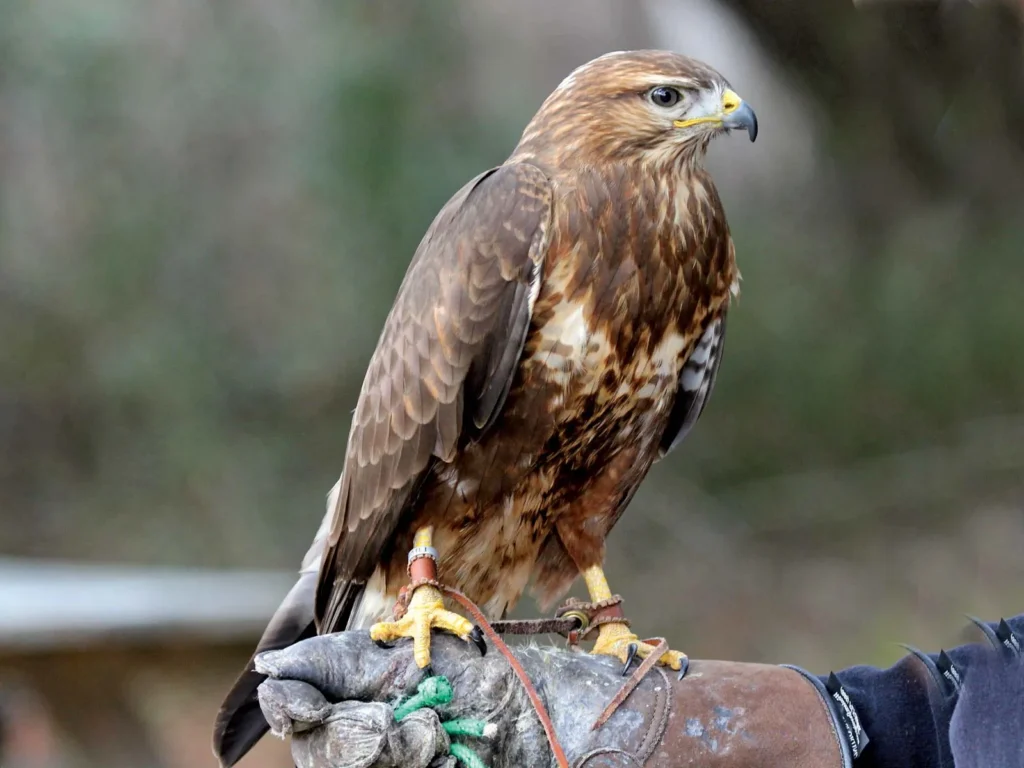
Buzzards are large birds of prey that soar effortlessly in the sky, scanning the ground for rabbits and rodents. In Europe, the Common Buzzard is widespread, and you’ll often see them perched on fence posts or gliding in wide circles high above fields.
They’re adaptable hunters and scavengers, thriving in woodlands, open countryside, and farmland.
Key Details:
- Scientific Name: Buteo buteo
- Wingspan: 42 to 53 inches (110 to 135 cm)
- Length: 16 to 22 inches (40 to 55 cm)
- Weight: 1.3 to 2.8 pounds (600 to 1,300 grams)
Next time you see a large bird soaring in lazy circles on a sunny day, there’s a good chance it’s a Buzzard keeping an eye out for its next meal.
7. Belted Kingfisher
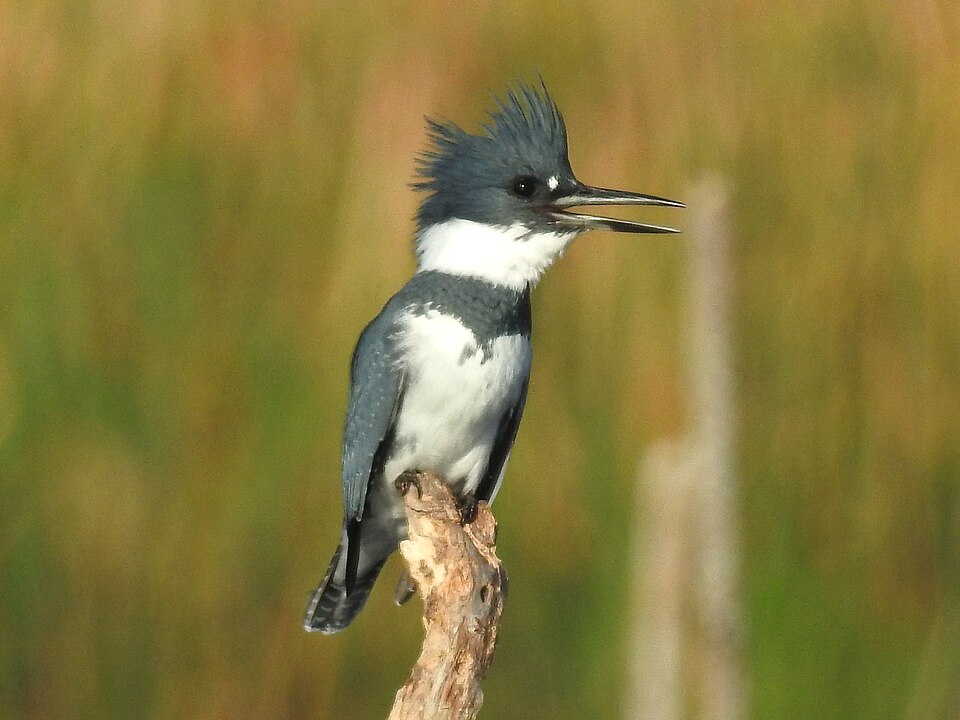
If you ever hear a loud, rattling call near a river or lake, look around — it might be a Belted Kingfisher perched on a branch above the water. These striking birds have shaggy crests and bold blue-gray plumage, with females sporting a unique rust-colored band across their bellies.
The Belted Kingfisher is a master fisher, often seen diving headfirst to catch small fish. They build nests by burrowing into riverbanks — a fascinating behavior that sets them apart from other birds.
Key Details:
- Scientific Name: Megaceryle alcyon
- Wingspan: 19 to 23 inches (48 to 58 cm)
- Length: 11 to 14 inches (28 to 35 cm)
- Weight: 4.9 to 6 ounces (140 to 170 grams)
Next time you’re near water, keep an eye out for a flash of blue and listen for that unmistakable rattle — you’ll know a Belted Kingfisher is nearby.
8. Bowerbird
One of the most unique birds that start with B is the Bowerbird, famous for its elaborate courtship displays. Native to Australia and New Guinea, male Bowerbirds build intricate structures called bowers, decorating them with colorful objects like flowers, shells, and even bits of plastic to attract a mate.
There are over 20 species of Bowerbirds, each with their own artistic flair. Some even paint their bowers with chewed-up berries or charcoal!
Key Details:
- Scientific Name: Ptilonorhynchidae (family)
- Wingspan: Varies by species, 12 to 18 inches (30 to 45 cm)
- Length: 8 to 16 inches (20 to 40 cm)
- Weight: 3 to 8 ounces (85 to 230 grams)
Watching a Bowerbird’s courtship dance is like seeing a real-life art performance — nature’s creativity at its finest.
9. Black Swan
Graceful and elegant, the Black Swan is native to Australia but has also been introduced to New Zealand and parts of Europe. Unlike the typical white swan, these stunning birds are jet black with striking red bills and white flight feathers visible when they spread their wings.
They’re mostly found in wetlands, lakes, and rivers, gliding majestically across the water. Black Swans are known for forming strong pair bonds and elaborate synchronized displays.
Key Details:
- Scientific Name: Cygnus atratus
- Wingspan: 5.2 to 6.6 feet (1.6 to 2 meters)
- Length: 43 to 56 inches (110 to 142 cm)
- Weight: 8.2 to 20 pounds (3.7 to 9 kg)
If you ever get the chance to see Black Swans in the wild, take a moment to watch their elegant movements — they’re truly a sight to remember.
10. Brambling
The Brambling is a small, colorful finch that brings a splash of orange and white to European woodlands and gardens, especially during winter. They migrate in huge flocks from Scandinavia and Russia to milder regions.
With their black heads, orange breasts, and white bellies, Bramblings stand out among other finches. They feed on seeds and insects and can often be seen foraging on the ground under trees.
Key Details:
- Scientific Name: Fringilla montifringilla
- Wingspan: 9 to 10 inches (23 to 25 cm)
- Length: 5.5 to 6.3 inches (14 to 16 cm)
- Weight: 0.6 to 1 ounce (18 to 28 grams)
Set up seed feeders in your yard in winter, and you might just see a flock of Bramblings stopping by for a snack.
11. Bluebird
The Bluebird is a symbol of happiness and hope in many cultures — and it’s easy to see why. These small thrushes have vibrant blue plumage and sweet, melodic songs. In North America, Eastern, Western, and Mountain Bluebirds each add their own charm to open fields and woodlands.
Bluebirds feed mostly on insects and berries. Providing nest boxes can help boost local populations, which suffered declines in the past.
Key Details:
- Scientific Name: Sialia spp.
- Wingspan: 9.8 to 12.6 inches (25 to 32 cm)
- Length: 6.3 to 8.3 inches (16 to 21 cm)
- Weight: 1 to 1.2 ounces (28 to 34 grams)
Attract them with mealworms or berry bushes, and you might be rewarded with these cheerful blue flashes in your garden.
12. Black Kite
The Black Kite is one of the most widespread birds of prey, found across Europe, Asia, Africa, and Australia. These medium-sized raptors are skilled scavengers and hunters, often seen soaring gracefully in the sky, effortlessly riding thermals.
They’re adaptable and thrive near water bodies, cities, and farmlands, feeding on fish, small mammals, and carrion.
Key Details:
- Scientific Name: Milvus migrans
- Wingspan: 49 to 59 inches (125 to 150 cm)
- Length: 19 to 24 inches (48 to 60 cm)
- Weight: 1 to 2.3 pounds (500 to 1,050 grams)
Spotting a Black Kite is easy once you know their distinctive forked tails and graceful flight style.
13. Barn Swallow
The Barn Swallow is one of the most familiar and beloved swallows worldwide. Recognizable by their deeply forked tails and glossy blue backs, they’re agile fliers, catching insects on the wing.
Barn Swallows often build mud nests under eaves, bridges, or inside barns. Their cheerful chatter and graceful swooping make them a favorite sign of spring.
Key Details:
- Scientific Name: Hirundo rustica
- Wingspan: 12.6 to 13.8 inches (32 to 35 cm)
- Length: 5.9 to 7.5 inches (15 to 19 cm)
- Weight: 0.6 to 0.7 ounces (17 to 20 grams)
If you see these aerial acrobats darting over fields and ponds, you know warm weather has arrived.
14. Bearded Vulture
Also called the Lammergeier, the Bearded Vulture is a dramatic sight in the mountains of Europe, Asia, and Africa. With striking facial markings that look like a beard, this huge bird of prey feeds mostly on bone marrow — dropping bones from great heights to crack them open.
They’re perfectly adapted to high altitudes and have a wingspan that makes them one of the largest birds of prey.
Key Details:
- Scientific Name: Gypaetus barbatus
- Wingspan: 7.5 to 9.3 feet (2.3 to 2.8 meters)
- Length: 37 to 49 inches (94 to 125 cm)
- Weight: 9.9 to 17 pounds (4.5 to 7.5 kg)
Seeing a Bearded Vulture soaring over rugged peaks is an unforgettable experience for any birder.
15. Boat-tailed Grackle
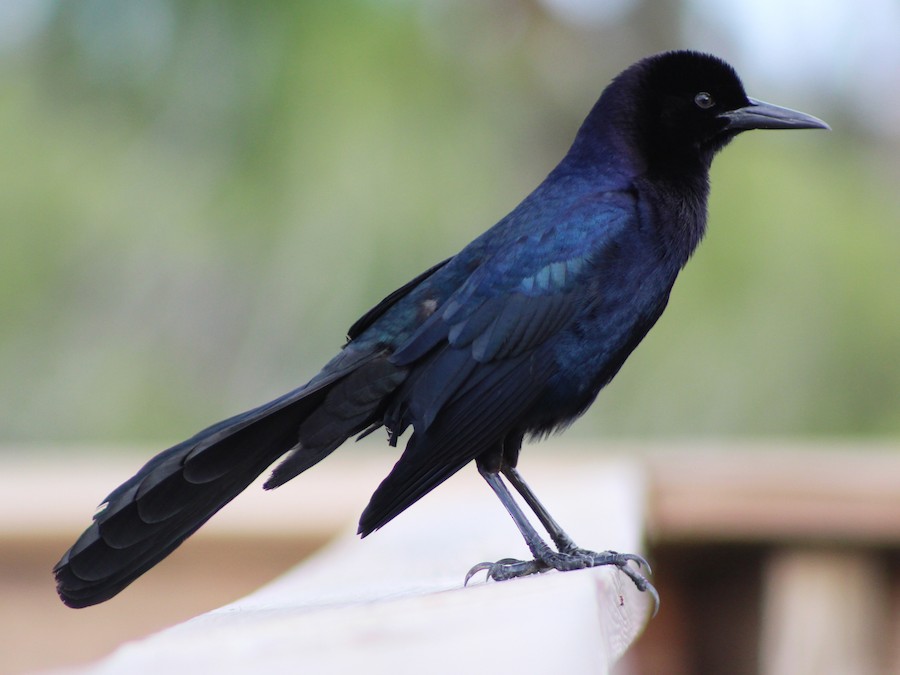
Boat-tailed Grackles are striking blackbirds of coastal marshes in the southeastern United States. Males are glossy black with bright yellow eyes and long, keel-shaped tails that they dramatically fan out during displays.
These social birds gather in noisy flocks and are known for their loud, varied calls. They forage for insects, small fish, and scraps near water.
Key Details:
- Scientific Name: Quiscalus major
- Wingspan: 15 to 20 inches (38 to 50 cm)
- Length: 15 to 17 inches (38 to 43 cm)
- Weight: 5.6 to 8.8 ounces (160 to 250 grams)
Next time you visit a coastal wetland, keep an ear out for these bold blackbirds.
16. Buff-breasted Sandpiper
The Buff-breasted Sandpiper is a delicate, elegant shorebird known for its warm buff-colored chest and soft, scaly back pattern. These birds migrate thousands of miles each year, breeding in the Arctic tundra and wintering in South America’s grasslands.
During courtship, males display in small leks, performing charming dances and wing-raising displays to impress females.
Key Details:
- Scientific Name: Calidris subruficollis
- Wingspan: 18 inches (46 cm)
- Length: 7.5 to 8.3 inches (19 to 21 cm)
- Weight: 1.4 to 2.1 ounces (40 to 60 grams)
To spot one, look for open grassy areas, not just mudflats — they often prefer dry habitats during migration, which makes them unique among shorebirds.
17. Black Skimmer
With its extraordinary bill — the lower mandible longer than the upper — the Black Skimmer is truly distinctive. They fly low over the water, skimming the surface to catch fish in dramatic fashion.
These striking birds have bold black-and-white plumage and bright orange bills. They’re found along coastal beaches and estuaries in the Americas.
Key Details:
- Scientific Name: Rynchops niger
- Wingspan: 42 to 50 inches (107 to 127 cm)
- Length: 15.8 to 19.7 inches (40 to 50 cm)
- Weight: 9.3 to 12.9 ounces (265 to 365 grams)
Seeing them feed at dusk, gliding inches above the water, is one of the most mesmerizing sights in birding.
18. Brown Thrasher
The Brown Thrasher, often heard before it’s seen, is known for its rich repertoire of over 1,000 song variations — the largest of any North American bird. Its rufous-brown plumage and heavily streaked chest make it easy to identify.
These secretive birds prefer dense shrubs and thickets, where they forage for insects and berries with long, curved bills.
Key Details:
- Scientific Name: Toxostoma rufum
- Wingspan: 11 to 13 inches (28 to 33 cm)
- Length: 9.1 to 11.8 inches (23 to 30 cm)
- Weight: 2.1 to 3.1 ounces (61 to 89 grams)
If you keep native shrubs in your garden, you might hear the Brown Thrasher’s complex melodies nearby.
19. Bohemian Waxwing
Bohemian Waxwings look almost unreal, with silky gray plumage, crested heads, and bright red wax-like tips on their wing feathers. In winter, they gather in large, noisy flocks, moving from tree to tree to feast on berries.
They breed in northern forests and migrate south in search of food during harsh winters.
Key Details:
- Scientific Name: Bombycilla garrulus
- Wingspan: 13.8 to 14.8 inches (35 to 38 cm)
- Length: 7.5 to 9 inches (19 to 23 cm)
- Weight: 1.6 to 2.3 ounces (45 to 65 grams)
Watch for these beautiful birds in parks and gardens full of winter berries.
20. Bluethroat
The Bluethroat is a small, striking songbird with a dazzling blue throat patch often edged with red or white. Found across Europe and Asia, this bird prefers dense reed beds and willow thickets near water.
In spring, males sing loudly from exposed perches, showing off their colorful throats during display flights.
Key Details:
- Scientific Name: Luscinia svecica
- Wingspan: 7.9 to 10.2 inches (20 to 26 cm)
- Length: 5.1 to 5.5 inches (13 to 14 cm)
- Weight: 0.5 to 0.8 ounces (14 to 23 grams)
Their vivid coloring and spirited songs make them a treat for any birder to find.
21. Black Grouse
Famous for their dramatic spring courtship displays called “lekking,” Black Grouse males fan their lyre-shaped tails and puff out their white wing patches to impress females.
These birds live in moorlands, forest edges, and upland areas across Europe and Asia.
Key Details:
- Scientific Name: Lyrurus tetrix
- Wingspan: 28 to 33 inches (70 to 85 cm)
- Length: 17 to 23 inches (43 to 58 cm)
- Weight: 2.2 to 4.4 pounds (1 to 2 kg)
Observing a Black Grouse lek at dawn is considered a highlight among European birders.
22. Black Tern
The Black Tern is a graceful marsh tern with sooty black plumage during breeding season, transforming to pale gray and white afterward. Unlike other terns, they rarely dive; instead, they catch insects in flight over wetlands.
They breed in freshwater marshes across North America and Europe.
Key Details:
- Scientific Name: Chlidonias niger
- Wingspan: 23.6 to 25.6 inches (60 to 65 cm)
- Length: 9.1 to 10.2 inches (23 to 26 cm)
- Weight: 2.1 to 2.5 ounces (60 to 70 grams)
Look for them fluttering low over ponds and marshes, graceful and quick.
23. Bufflehead
The Bufflehead is a small, striking duck known for the male’s large, white head patch that shines iridescent green and purple in sunlight. They breed in tree cavities near lakes and winter in coastal bays and ponds.
Agile divers, Buffleheads feed on aquatic insects, crustaceans, and plants.
Key Details:
- Scientific Name: Bucephala albeola
- Wingspan: 21.6 inches (55 cm)
- Length: 12.6 to 15.7 inches (32 to 40 cm)
- Weight: 9.5 to 19.4 ounces (270 to 550 grams)
Spotting their quick dives and energetic swimming adds color to any winter birding day.
24. Bullfinch
Bullfinches are charming birds with chunky bodies and distinctive appearance: males boast bright pinkish-red underparts, while females are softer gray. Both sexes have black caps and stubby bills perfect for crushing seeds.
Native to Europe and parts of Asia, they’re often found in woodlands, orchards, and gardens.
Key Details:
- Scientific Name: Pyrrhula pyrrhula
- Wingspan: 8.7 to 10 inches (22 to 25.5 cm)
- Length: 5.5 to 6.3 inches (14 to 16 cm)
- Weight: 0.7 to 1 ounce (21 to 27 grams)
Their gentle, melancholy call is a lovely sound in any quiet woodland.
25. Buttonquail
Small, elusive, and more often heard than seen, Buttonquails live in grasslands and scrub across Africa, Asia, and parts of Europe. Unlike true quail, females are often more colorful and do the calling and courting.
They forage for seeds and insects, moving quickly through dense vegetation.
Key Details:
- Scientific Name: Turnicidae (family)
- Wingspan: About 10 to 11 inches (25 to 28 cm)
- Length: 5 to 7 inches (13 to 18 cm)
- Weight: 1 to 2 ounces (30 to 60 grams)
Their secretive lifestyle makes even a quick glimpse rewarding for birdwatchers.
FAQs
1. How many bird species start with the letter B?
There are hundreds of bird species that start with B globally, ranging from tiny songbirds to large birds of prey. This list covers 25 of the most interesting and recognizable ones.
2. Where can I see these birds?
Many “B” birds can be found in North America, Europe, Asia, and beyond. Your local environment, season, and habitat type will determine which ones you might see.
3. How can I attract “B” birds to my backyard?
Providing food like seeds, suet, or nectar, fresh water, and safe shelter are the best ways to attract birds like Blue Jays, Black-capped Chickadees, and Blackbirds.
4. Are any “B” birds endangered?
Some birds that start with B, like the Bearded Vulture or certain Bustard species, are threatened due to habitat loss and other pressures. Supporting conservation helps protect them.
5. What is the best time of year to see these birds?
Spring and summer are usually the best for spotting many birds as they migrate and breed, but some species, like Chickadees and Blackbirds, can be seen year-round.
Conclusion
Birds are among the most fascinating creatures you can observe, and narrowing your focus to a single letter like “B” is a fun way to learn more about them. Whether you’re watching a Barn Owl glide through the night, enjoying the cheerful chatter of a Blue Jay in your backyard, or spotting a Bald Eagle in the wild, each of these birds adds its own magic to the world.
Hopefully, this list inspires you to grab your binoculars, head outside, and connect with nature in a fresh way. Keep exploring, keep learning, and remember — every bird you spot tells a story about the amazing diversity of life on Earth.
Happy birdwatching!
